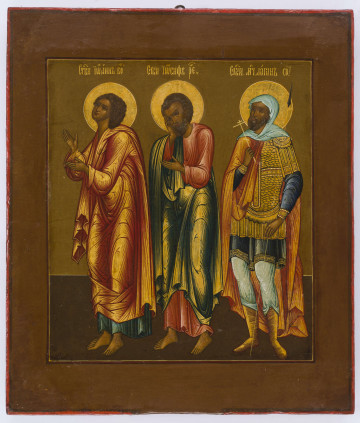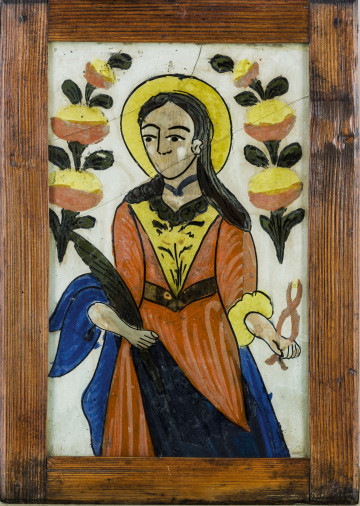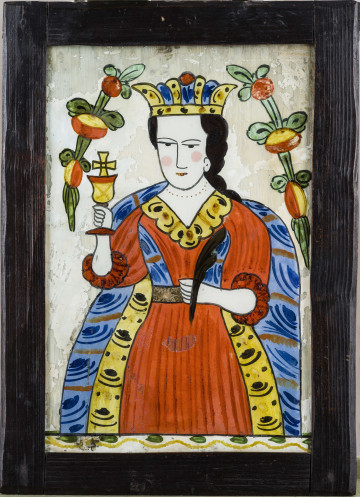
Ascension / Saints John, Joseph and Longinus
1801 — 1900
National Museum in Lublin
Part of the collection: Folk Art of the Lublin Region (17th–1st half of the 20th c.)
In Poland, painting on glass began to develop in the 18th century in Lower Silesia, where in the vicinity of glassworks workshops were established that developed their own patterns, influencing almost all regions of Poland. Polish centres also maintained contacts with similar workshops in the Czech Republic or Slovakia, from where some formal solutions were borrowed. Itinerant sellers of paintings, which were characterised by: white, dark blue or black background, red-brown and black outline, robes of figures enriched with gilding and floral decoration in the form of stylised pomegranate apple in the form of yellow and red ball or three- or five-petalled tulip, usually red, reached the Polish villages in Podhale, Orava or Spisz.
The 19th century proved to be a golden age in the history of the technique. At that time, glass paintings were commonly used to decorate peasants' cottages. They depicted figures of saints, who played an important role in the folk conception of the world, namely their task was to protect the house and its inhabitants and the immediate surroundings of the farm. The themes were dominated by images of the Virgin Mary and patron saints, intermediaries in all earthly affairs, including St Agatha, St Apolonia, St Barbara, St John of Nepomuk. The greater the number of images of saints in a cottage, the better protection the owner and his family could count on.
The paintings on glass were produced on a continuous basis in huge amounts, according to accepted patterns. They were produced using ready-made patterns, usually devotional graphics such as woodcuts or copper engravings. It was placed under the glass sheet and copied by painting the contours directly onto the glass. Thus, the general scheme of the composition was reflected, while the details were left to the artist's imagination. Individualism was particularly evident in the floral decorations of the background. Sometimes the painters omitted attributes of the saints or added others. Sometimes it was difficult to recognise the saint in the paintings. The patterns were reflected from the backgrounds and, therefore, a mirror-like effect was often obtained. The mechanical reproduction of the signatures under the figures, which could only be read in reverse, often revealed illiteracy on the part of the copiers, as well as when they omitted letters or wrote them distorted.
Author / creator
Dimensions
cały obiekt: height: 32,5 cm, width: 41 cm
Object type
picture
Material
glass, oil-based paint
Creation time / dating
Creation / finding place
Owner
The National Museum in Lublin
Identification number
Location / status

1801 — 1900
National Museum in Lublin

1801 — 1900
National Museum in Lublin

1801 — 1900
National Museum in Lublin
DISCOVER this TOPIC
Museum of King Jan III's Palace at Wilanów
DISCOVER this PATH
Educational path